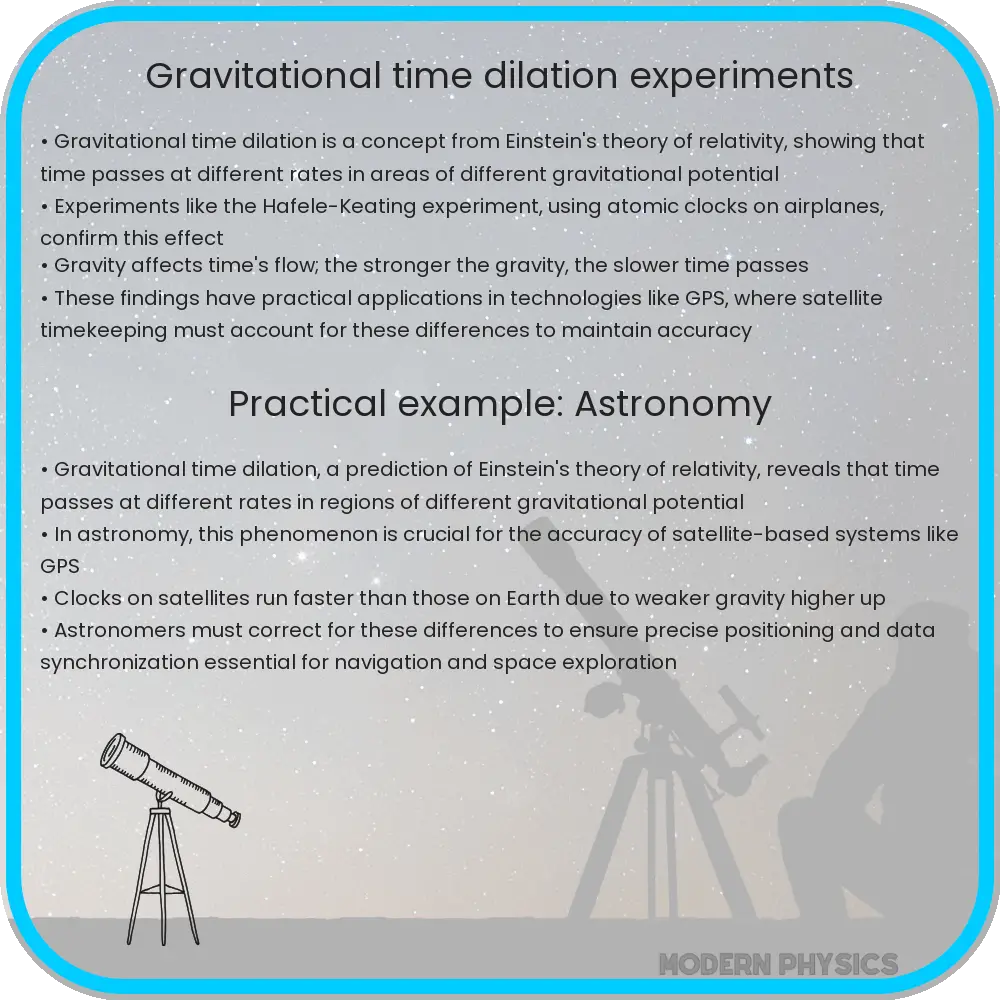Explore gravitational time dilation’s impact on physics, from Einstein’s theory to GPS tech and cosmic phenomena, reshaping our understanding of time.

Understanding Gravitational Time Dilation: Theory and Tests
Gravitational time dilation, a concept rooted in Albert Einstein’s Theory of General Relativity, describes the phenomenon where time runs slower in stronger gravitational fields. This fascinating aspect of physics not only enhances our understanding of the universe but also challenges our perception of time as a constant entity.
Theoretical Foundations
The principle of gravitational time dilation emerges from Einstein’s equation for General Relativity, which can be expressed as Gμν = 8πTμν, where Gμν represents the curvature of spacetime and Tμν the matter-energy content. In layman’s terms, this equation implies that massive objects like planets and stars warp the fabric of spacetime, affecting the passage of time nearby.
Experimental Validation
Gravitational time dilation is not just a theoretical prediction; it has been experimentally verified through various tests. One of the earliest confirmations came from the Pound-Rebka experiment in 1959, which used the Mössbauer effect to measure the frequency shift of gamma rays in Earth’s gravitational field. The results were in remarkable agreement with General Relativity’s predictions.
Real-World Applications and Implications
One of the most practical implications of gravitational time dilation is seen in the Global Positioning System (GPS). Satellites in orbit experience less gravitational pull than those on Earth, leading to a faster passage of time. This effect, although minuscule, must be accounted for in the satellite’s clocks to ensure the accuracy of GPS positioning. Without adjustments for these relativistic effects, GPS systems would accumulate errors of several kilometers per day.
Gravitational time dilation also has profound implications for our understanding of the universe. It plays a crucial role in astrophysical phenomena such as the behavior of light near black holes, where the gravitational pull is so strong that it significantly slows down time. This phenomenon is also a key element in understanding the age and expansion rate of the universe.
Continued research and exploration in this field not only deepen our understanding of the universe but also challenge and expand the frontiers of physics. Gravitational time dilation, a cornerstone of modern physics, continues to intrigue scientists and enthusiasts alike, offering a glimpse into the enigmatic nature of time and space.
Advanced Experiments and Observations
Recent advancements in technology have allowed for more sophisticated experiments to test gravitational time dilation. The Gravity Probe A mission, for instance, involved a hydrogen maser clock placed aboard a rocket that reached an altitude of 10,000 kilometers. The experiment confirmed that time passed faster at higher altitudes, precisely as predicted by General Relativity. Such tests not only validate Einstein’s theories but also enhance our understanding of gravitational effects in space travel and satellite communications.
Implications in Cosmology and Astrophysics
In the realm of cosmology and astrophysics, gravitational time dilation plays a pivotal role. It is essential in the study of phenomena such as gravitational lensing, where light from distant stars is bent around massive objects like galaxies, altering our perception of time and space. This effect is crucial in estimating the mass of these celestial bodies and understanding the expansion of the universe. Additionally, time dilation is a key element in the analysis of pulsars and black holes, providing insights into their properties and behaviors.
Philosophical and Theoretical Considerations
The concept of time dilation goes beyond physics, posing profound philosophical questions about the nature of time and reality. It challenges the notion of absolute time, suggesting that time is relative and dependent on one’s frame of reference and gravitational potential. This has led to intriguing thought experiments in the realms of philosophy and theoretical physics, further blurring the lines between science and philosophy.
Future Prospects and Challenges
Looking to the future, gravitational time dilation remains a field ripe for exploration. Scientists aim to conduct more precise experiments, possibly in deeper space, to test the limits of General Relativity. These endeavors may pave the way for new theories or modifications to existing ones, especially as they intersect with the enigmatic realm of quantum mechanics. The challenge lies in devising experiments that can accurately measure time differences under extreme gravitational conditions.
Conclusion
Gravitational time dilation is a cornerstone of modern physics, profoundly impacting our understanding of time, space, and the universe. From its theoretical underpinnings in Einstein’s General Relativity to its practical applications in GPS technology and cosmological research, this phenomenon continues to fascinate and challenge scientists. As we venture further into the cosmos and delve deeper into the mysteries of the universe, gravitational time dilation stands as a testament to the human quest for knowledge, reminding us that the nature of reality is far more complex and intertwined than we once thought. The journey of understanding gravitational time dilation is not just about comprehending the universe but also about redefining our place within it.
